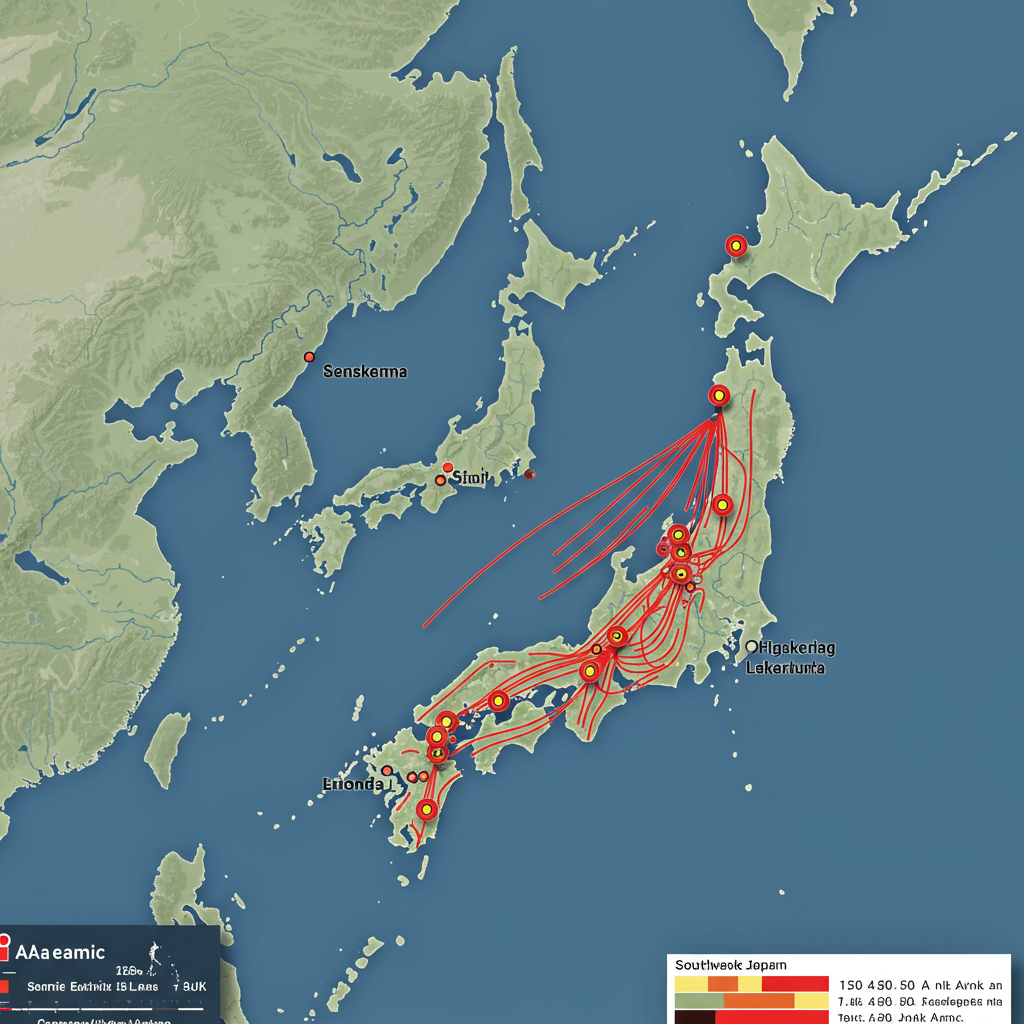japan, a nation familiar with the earth’s powerful movements, is currently experiencing a significant surge in seismic activity. Over the past two weeks, residents near the Tokara island chain in Kagoshima prefecture, southwest of Kyushu, have felt the ground tremble repeatedly. This series of tremors has intensified concerns, particularly in the face of widespread, unfounded predictions of a major impending disaster.
Government officials have acknowledged the increased seismic activity. They issued warnings on Saturday about the potential for further strong earthquakes in the waters near the main islands. However, authorities are simultaneously making an urgent appeal to the public: do not believe unscientific and unfounded predictions regarding a catastrophic event.
Decoding the Tokara Island Quake Swarm
The recent seismic unrest has been concentrated around the Tokara island chain. This area, known for its active volcanoes, has been rattled by an extraordinary number of quakes. Since June 21, 2024, more than 1,000 earthquakes have been recorded in this specific region.
The Japan Meteorological Agency (JMA) reported a staggering 474 earthquakes in the Tokara chain between June 21 and June 27 alone. The seismic activity peaked dramatically, with 183 tremors hitting the islands on June 23. While the daily count dipped later, it rose again towards the end of June.
Several tremors have been strong enough to cause concern and disruption. On Thursday, a magnitude 5.5 quake struck off the coast of Kyushu. This was followed by a magnitude 5.4 tremor on Saturday. Among the numerous quakes in the Tokara chain, two magnitude 5.1 tremors were noted as particularly strong. Some of these events were intense enough to make standing difficult for residents.
Despite the high frequency and intensity of some quakes, no major damage has been widely reported across the affected islands. Authorities have urged residents to remain vigilant. As a precautionary measure, some residents from the remote Tokara islands were evacuated on Friday.
Ayataka Ebita, director of the JMA’s earthquake and tsunami monitoring division, commented on the situation. He cautioned about an increased risk of potential issues like collapsed houses or landslides in areas experiencing strong tremors. He also explicitly warned of the possibility of “earthquakes of similar magnitude for the foreseeable future” in the region.
Japan’s Position on the Ring of Fire
Understanding the context of Japan’s seismic activity is crucial. The country is situated in one of the world’s most seismically active areas. It lies along the Pacific “Ring of Fire,” atop four major tectonic plates. This geological setting makes earthquakes a common occurrence.
Japan accounts for approximately one-fifth of all earthquakes globally with a magnitude of 6 or greater. The country experiences roughly 1,500 jolts annually. This represents about 18 percent of the world’s total earthquakes. Experts suggest the unusual topography around the Tokara islands may contribute to the current pressure build-up and subsequent quake releases.
Beyond localized swarms, Japan faces significant long-term seismic risks. A government panel earlier this year slightly increased the probability of a major earthquake in the Nankai Trough. This offshore region along Japan’s Pacific coast has a 75 to 82 percent chance of a major jolt within the next 30 years. A revised government estimate from March projected potentially devastating consequences from a Nankai Trough megaquake and tsunami, including up to 298,000 deaths and estimated damage up to $2 trillion.
Rumors Fueled by a Manga Prophecy
Amidst the genuine seismic activity, public anxiety has been significantly amplified by rumors. These fears largely stem from interpretations of a specific Japanese comic book. The manga, titled “The Future I Saw” by Ryo Tatsuki, was first published in 1999 and re-released in 2021.
This particular manga reportedly contained predictions that have resonated with some members of the public. It is claimed to have predicted a “megaquake,” potentially exceeding magnitude 8.0, would strike Japan on July 5, 2024. The prophecy also allegedly mentioned a “huge” tsunami “three times the size” of the devastating one that followed the 2011 Great East Japan Earthquake. This tsunami was also predicted to affect other countries in the Pacific Ocean.
Social media platforms saw a “frenzy” of discussion related to this prediction. Posts ranged from anticipation and fear to, later, relief as the predicted date passed without the forecast catastrophic event.
The Impact on Public Perception and Tourism
The widespread circulation of these predictions has had tangible effects. While officials work to provide accurate, science-based information, the unfounded rumors have created panic among some.
The impact even extended to tourism. According to the article, data shows a notable decline in tourist arrivals from Hong Kong. Arrivals were down 11 percent in May compared to the same month last year. This drop occurred following the extensive sharing of the manga prediction, despite Japan otherwise enjoying record visitor numbers. April 2024, for instance, set a record monthly high with 3.9 million travelers to the country.
The artist behind the manga, Ryo Tatsuki, has reportedly addressed the situation. Through her publisher, she issued a statement clarifying that she is “not a prophet.”
Science vs. Unfounded Predictions
Japanese authorities and meteorological experts have been clear in their message. They strongly urge the public to rely on scientific evidence when understanding seismic risks. Ayataka Ebita of the JMA explicitly stated the current limitations of seismology. “With our current scientific knowledge, it’s difficult to predict the exact time, place or scale of an earthquake,” he explained at a press conference.
The government’s warning of potential further strong earthquakes is based on scientific monitoring and understanding of geological patterns following a swarm. This differs fundamentally from the unscientific claim of a specific, date-bound catastrophe predicted in a fictional work. Officials continue to emphasize the need for vigilance based on meteorological data and safety guidelines, rather than unfounded fears.
Japan’s preparedness infrastructure is robust, built on decades of experience with seismic activity. The focus remains on monitoring, early warnings where possible (like for tsunamis after a major quake), and public education on safety measures during tremors.
In conclusion, while Japan is currently experiencing a notable increase in localized seismic activity around the Tokara Islands, the government is actively working to manage public anxiety. Officials are providing scientific updates and preparedness advice while simultaneously debunking fears stoked by a non-scientific prediction. The ongoing situation highlights the critical importance of relying on trusted scientific sources and official information during periods of natural heightened risk.
Frequently Asked Questions
What is happening with earthquakes in Japan’s Tokara Islands?
The Tokara island chain in Kagoshima prefecture, southwest Japan, has experienced a significant swarm of earthquakes recently. Since June 21, 2024, over 1,000 tremors have been recorded in the area. This includes strong quakes, some making standing difficult, like a magnitude 5.5 and a magnitude 5.4. Authorities have issued warnings about potential further strong tremors and advised residents to remain vigilant, even carrying out some evacuations.
How is the Japanese government responding to the earthquake activity and public fears?
The Japanese government is monitoring the seismic activity closely and warning of the possibility of more strong earthquakes based on scientific assessment. Crucially, they are also urging the public to disregard unscientific predictions of a major disaster. Officials, including from the Japan Meteorological Agency (JMA), emphasize that current science cannot predict the exact time, place, or scale of earthquakes and encourage reliance solely on official, scientific information.
Is the earthquake prediction from “The Future I Saw” manga scientifically supported?
No, the prediction reportedly found in “The Future I Saw” manga, suggesting a major earthquake on a specific date in July, is not scientifically supported. Meteorological experts and the Japanese government have explicitly stated that earthquake prediction is not possible with current scientific knowledge. They strongly urge the public to base their understanding on scientific evidence, not unfounded claims or fictional predictions. The artist of the manga has also reportedly clarified she is not a prophet.



